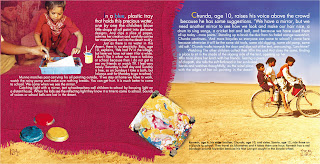I had written about Breakthrough earlier, way back in November 2005. I had just seen 'Maati', the beautiful video about an upper-class woman infected with HIV by her husband, and was totally blown away by the video's electric combination of stunning visuals, evocative lyrics and hard-hitting message. Can't find that video online, but another one worth watching is Mann Ke Manjeere (title song of the album and nominated for MTVs Best Indipop Music Video), and is here.
I remember getting some interesting comments from readers on the article, mostly from men. Probably not coincidental, since the article talked about getting men to well, be more sensitive to women by using condoms when requested to do so (and when not requested), and by being open about their previous sexual partners. Have posted some comments below:
From I. Ghosh, Chandigarh
It is true the men should keep there male chauvinisim at bay and realise there reponssibilites towards his life partner , his family and above all the society in which he lives.Like food ,shelter and education, after a certain age sex too plays an important part in a man's life.And I belive that it is the right of every human being to get the best knowledge about safe sex. At school children are taught about various deseases that spread through contaminated water and the precaution they should take. In the same way deseases relating to sex for example STD and AIDS must be a part of school syllaby after a certatin class, maybe in 11th and 12th grade.It should not be a taboo issue any more as AIDS is labelled as an epidemic with no cure yet. All we can do is act reponssibly and prevent it from spreading by first ,taking proper precaution on personal front and secondly by spreading the awareness.Since charity begins at home parents should feel free to take up the issue with their wards.Even elder siblings with proper knowledge can be a big help.Family physcian to can do his part....All we need now is to act ..
From Sanjay:
I have noticed a conspicuous evolution of themes especially related to advertisements, rather social messages built around curbing the spread of AIDS. If I recall correctly, the earlier campaigns were talking about the importance of having only one sexual partner. However now, we seemed to have accepted the reality that our initial plank was not strong and hence the promotion of condoms as a means to prevent the spread of virus.
I have also seen the commercial, if I can call it that way, asking the men to be more sensitive. But, from a target audience point of view, I wonder whether it will strike the right tone with the 'insensitive' men. I would say that it would have been better if they promoted something like with that advertisement. Also, I really doubt that if a condom can prevent the virus being spread – 100%. But of course it might be near 100%.
As your article suggests, the bigger challenge for India is to spread the awareness. I have read some years ago (should be at least 4 years) about prostitutes insisting their clients to wear condoms, and it was even reported that one prostitute even asked her clients to wear 2 condoms preferably. If awareness can reach groups like prostitutes who are considered inaccessible then why not the masses? Speaking about sex openly has been very un-Indian. However, if I have to go by the surveys done, at least in cities, doing sex is not. So in-addition to spreading the awareness among the people, one has to simultaneously concentrate on the younger generation – especially teenagers.









